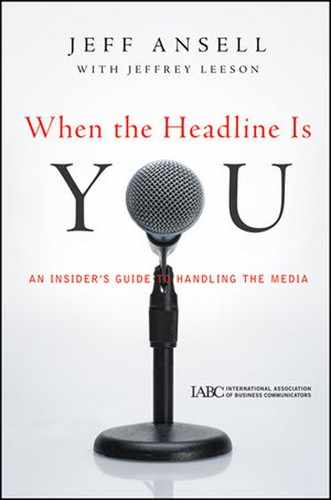Answering questions from reporters is risky business. Though a media interview may feel like a straightforward conversation, it actually represents a contrived and manipulative dynamic. Knowing how to talk to reporters is like learning a new language, a language that bears little if any resemblance to everyday conversation. It is a mistake for anyone to believe otherwise. It may seem as if speaking the truth should be enough to build credibility and trust, but that's rarely the case. Exposing oneself to media scrutiny requires more than simple candor. It requires knowledge, training, and a keen understanding of how reporters write the news.
In my nearly forty years of experience, I have yet to meet anyone for whom media skills come naturally. Answering tough questions from reporters is even difficult for reporters themselves. You would think being skilled in asking questions would provide insight into how best to answer them. I discovered otherwise, however, in a training session for famed Watergate journalist Carl Bernstein. In the training, my first question to Carl was whether he had a troubled relationship with his Watergate partner Bob Woodward. To my surprise, Carl put his foot in his mouth so deeply it came out the other end. I learned something important that day. Anyone can ask questions. The real skill is in answering them.
It should be of little surprise, then, that many executives, government leaders, and spokespeople are reluctant to engage the news media. Their concern is justified. People who talk to the media are only as good as their worst quote. Though someone answering a reporter's questions may strike all the right notes for the majority of the interview, it takes only a single miscue to trigger disaster. One misstatement to a reporter can destroy long-held goodwill or cause a company's share price to plummet. As legendary investor Warren Buffet said, "It takes twenty years to build a reputation and five minutes to ruin it."[1]
Historically, public relations professionals and media trainers have told clients to ignore questions they don't like and instead repeat scripted messages. The end result is that many people who talk to reporters come across as evasive and unresponsive. This approach to communicating—or rather the lack of it—has led to record levels of skepticism and distrust among the general public. To be better media communicators, newsmakers and spokespeople must learn how to answer confrontational questions with integrity while still limiting their exposure to the sensationalism of today's media environment. Using a values-based approach, When the Headline Is You provides a framework for addressing problematic issues in an open, forthright manner that eliminates both the possibility of misinterpretation and the risk of being taken out of context.
Offering strategies for navigating all types of media encounters, When the Headline Is You is intended to help everyone who interacts with journalists or reporters, including executives, spokespeople, PR representatives, and corporate communication professionals. The book will be equally helpful to the message makers behind the scenes: the public relations practitioners and communication consultants tasked with preparing media messages for challenging, newsworthy situations. In addition, academics and students in communication and journalism will find many of the real-world scenarios useful in developing a deeper understanding of how the media operates and building the core skills necessary to become persuasive communicators.
In providing a framework for creating meaningful messages, When the Headline Is You focuses on key principles and proven strategies for success in today's media-saturated world. I've organized these principles and strategies into clearly defined steps that mirror the process of preparing for a media encounter. This structure offers readers both the fundamental knowledge and the practical tools necessary to manage image and reputation even under the most stressful circumstances.
I start in Chapter One by providing an overview of how news is made, reported, and interpreted. In Chapter Two, readers will learn how to manage the initial encounter with a journalist, avoid common interview traps, and align organizational image with positive values. Chapter Three explains the key principles for building trust and provides a simple yet powerful formula for crafting bad news messages. In Chapter Four, I examine many different types of media messages and discuss a template for creating a comprehensive range of compelling responses and statements. Chapter Five follows with an in-depth discussion of successful public speaking techniques that will help readers optimize message delivery. Chapter Six examines difficult situations like surprise encounters and provides step-by-step strategies for effectively managing these situations. Finally, in Chapter Seven, I present specific techniques for answering twenty of the most potentially damaging questions that spokespeople commonly encounter.
Throughout the book, I've incorporated a number of special features and practical tools, including:
A complete Media Messaging Toolkit with reproducible templates and worksheets
Actual news stories and interview transcripts that bring concepts to life and illustrate essential media communication lessons
Sidebars that add context to salient ideas and provide additional practical strategies
Proven public speaking tips and a six-step message-delivery exercise that's guaranteed to improve your presentation skills
A recurring, illustrative example that depicts the entire media messaging process and clearly demonstrates implementation techniques
Chapter-ending "Talking Points" to help you review and reference critical concepts
When the Headline Is You is designed so you can easily navigate each chapter and locate specific topics and practical information. This means you can jump from chapter to chapter and pull out what you need, when you need it. But there's also an advantage to reading the chapters in order. The chapters are clearly linked and the techniques presented build on each other to facilitate your skill development.
No matter how you choose to use the book, my hope is that everyone who picks it up discovers valuable strategies and messaging formulae to use in communicating with reporters. Whether delivering good news, not-so-good news, or dealing with a full-blown media crisis, When the Headline Is You provides a process for crafting responsive messages that present your organization in a proactive, positive manner.
